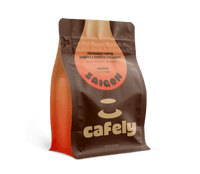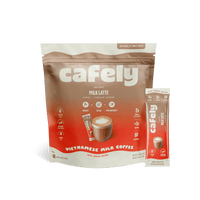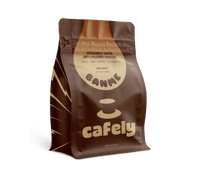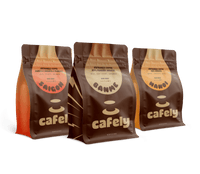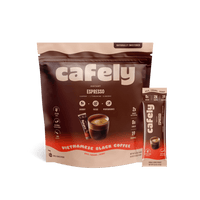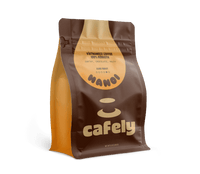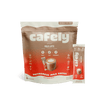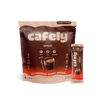White coffee is increasing in popularity amongst coffee enthusiasts. It’s characterized by its unique roasting process, which lends itself to distinct flavors and higher caffeine content, plus a variety of potential health benefits.
What Makes White Coffee Unique?
- Roasted at a lower temperature and for half as long as traditional roasts.
- The flavor is uniquely nutty and delicate.
- Lower acidity compared to dark roast coffee.
- Higher levels of antioxidants are retained throughout the roasting process.
- Higher caffeine content than average.
This guide dives into what white coffee is, how it’s different from more traditional roasts, and why you should try it.
What is White Coffee?
White coffee is made from the same green coffee beans as a traditional blonde or dark roast. What sets it apart is the roasting temperature and duration.
White coffee is roasted at a significantly lower temperature and for half as long as traditional roasts. The result is a delicate, unique flavor with more caffeine and less acidity.
The shorter roasting time prevents the typical darker colors and bitter flavors from developing. The coffee bean retains more of its natural flavors and oils, imparting a sweeter and nuttier flavor profile. Once roasted, the beans are whitish to yellow in color, unlike the dark, rich browns seen in traditional coffee.
Compared to other roasts like blonde or dark, white coffee is typically roasted at 325°F for a shorter duration. In comparison, darker roasts can be roasted at temperatures as high as 450°F degrees or more.
Comparison of Roasting Temperatures:
|
Type of Roast
|
Roasting Temperature
|
|
White
|
325°F
|
|
Blonde
|
350-400°F
|
|
Dark
|
Above 400°F
|
The duration of the roast is important as it changes the amount of caffeine as well as the flavor profile of the coffee once brewed. White coffee beans retain more of their natural flavors and avoid the typical bitterness attributed to higher roasting temperatures.
The faster roasting times also mean more caffeine is preserved. The white coffee beans can contain up to 50% more caffeine than a dark roast.
How to Brew White Coffee

White coffee beans have a harder and denser exterior compared to a more heavily roasted coffee bean. This means traditional coffee grinders can prove ineffective. Using a burr grinder or having a roasting company grind them for you is the best option.
Because white coffee is so dense, the compounds are also harder to extract. Here are some recommended brewing methods and tips for achieving the best results:
Recommended Brewing Methods For White Coffee:
- Espresso Machine — The higher pressure of an espresso machine brings out the nutty and sweet flavors of white coffee.
- Aeropress filter — Similar to a pressurized drip coffee, this manual process allows for maximum flavor extraction.
- Moka Pot — A stove-top espresso maker that works well with the finer grind of white coffee.
Tips for Grinding:
- Due to the harder texture, use a burr grinder to get achieve the right consistency.
- White coffee requires a finer grind and should resemble that of table salt or sugar.
- The delicate oils containing caffeine, antioxidants, and flavor are released as soon as the beans are ground, so grind right before you brew.
Health Benefits of White Coffee
White coffee boasts several potential health benefits, largely due to the shorter roasting time and lower roasting temperature. This preserves the oils and protects the antioxidants and aromas from breaking down [1].
Let’s take a look at how this can boost the health advantages of white coffee.
Higher Chlorogenic Acid Content
- White coffee retains more antioxidants, such as chlorogenic acid, which are significantly depleted at higher roasting temperatures [2].
- Chlorogenic acid has been linked to various health benefits, including reduced inflammation and reduced risk of certain cardiovascular diseases [3].
Antioxidant & Caffeine Benefits
- Studies suggest that antioxidants in coffee can help combat oxidative stress and inflammation in the body [4].
- Antioxidants have been proven to help reduce the risk of chronic diseases [5].
- Caffeine can help support a healthier weight, increase mood, and lower risk for depression [6].
- There are higher concentrations of caffeine in green coffee beans that decrease with the roasting process [7].
Lower Acidity
- Lower roasting temperatures result in less acidic coffee [8].
- A lower acidity can help those with a sensitive stomach or those with digestive issues [8].
Flavor Profile of White Coffee
When coffee beans are roasted at high temperatures or for long durations, they develop that classic smoky bitterness commonly associated with black coffee. White coffee has a milder and cleaner taste, often described as sweet or nutty and tea-like compared to the bitter, stronger flavors coffee enthusiasts are used to.
The taste of white coffee varies depending on where the beans originated from and how they are prepared, but many describe notes of peanut butter, caramel, or earthy flavors. Due to the lighter color of the beans themselves, the color of the brewed coffee is very light as well and more translucent than regular coffee.
Many pairings go well with white coffee. Some choose to mix it with cream, steamed milk, spices, caramel, or vanilla coffee creamer — which you can easily enhance by learning how to make vanilla coffee creamer at home using simple ingredients. Others mix it with a shot or two of a darker roast to balance a more traditional coffee flavor with the lightness of the white coffee.
Explaining The Cult Status of White Coffee
White coffee has grown in popularity over the last few years and has grown a cult following among coffee enthusiasts. It can now be found in specialty shops and cafes and has quickly become a notable trend in coffee culture across the globe.
The Middle East
Originating in Yemen, this beverage has traditionally been consumed as a light brew mixed with a blend of spices like cinnamon, clove, and nutmeg called hawaij. Different regions have adopted the drink and adapted to the white coffee trend with additional flavor profiles, spices, and additives.
The West
In Western culture, white coffee is more of a specialty niche market. Here, most consumers prefer to serve their white coffee over milk in lattes or with flavored syrups like caramel and vanilla.
As awareness increases, it’s likely the popularity will as well. The higher caffeine content and health benefits from the higher antioxidant levels contribute to the popularity of the drink, while others appreciate the unique coffee experience and novel flavors.
FAQs: White Coffee

1: Is white coffee less acidic than regular coffee?
Yes, longer roasting times typically lead to higher acidity. The shorter roasting of white coffee gives it a significantly less acidic makeup. This makes it a suitable option for individuals with sensitive stomachs or those prone to acid reflux.
Related: Why Does Coffee Make Me Poop?
2: Can white coffee be brewed in a regular coffee maker?
Due to the density of the bean, more specific methods like espresso or Aeropress are recommended. A regular drip coffee maker may not be able to extract enough of the delicate flavors as effectively as you need a finer grind.
3: Does white coffee contain more caffeine than regular coffee?
Yes, white coffee contains more caffeine due to the shorter roasting process. Darker brews have more caffeine burned off when roasted, making white coffee a great option for those looking for an energy boost.
4: What does white coffee taste like?
White coffee is lighter and milder than traditional coffee. It tends to have a sweeter and nuttier taste with flavors of caramel and earthy notes, with a tea-like color.
5: Where can I buy white coffee?
White coffee is available in many specialty coffee shops, cafes, and through online retailers. As its popularity grows, it’s becoming easier to find on store shelves and coffee shop menus.
6: Is white coffee more expensive than regular coffee?
Due to its niche market, the special handling and preparation needed, and the unique roasting process, it can carry a higher price tag.
7: How should white coffee beans be stored?
White coffee should be stored like traditional coffee. Keep it in a cool, dark place in an airtight container. White coffee contains more delicate oils and proper storage keeps them fresher for a longer period.
8: Can white coffee be used in all coffee recipes?
White coffee can be substituted in most recipes and is commonly used in lattes, americanos, and flavored coffee drinks like iced coffees. However, the delicate flavor profile might not pair well with every coffee recipe, depending on individual taste and preference.
9: Is white coffee suitable for all coffee drinkers?
White coffee is a great option for those looking for a highly caffeinated, less acidic coffee beverage. The unique flavors have captured a devoted following. However, it may not appeal as much to those who prefer the boldness of darker roasts, and it’s not ideal if you want to limit caffeine.
10: How has white coffee evolved over the years?
Traditionally consumed in Yemen, the unique brewing process has been used for over 50 years. Its growing popularity has gained the attention of coffee enthusiasts all over the globe. White coffee is likely to continue to evolve as awareness grows.
References
- Alqarni M., Alam P., Salkini M., Abdel-Kader M., Saad A.-K. Roasting effect on the caffeine contents and antioxidant potential of different coffee grades available in the Saudi market. Indo Am. J. Pharm. 2018;5:16738–16745. doi: 10.5281/zenodo.2505094.
- Awwad S, Issa R, Alnsour L, Albals D, Al-Momani I. Quantification of Caffeine and Chlorogenic Acid in Green and Roasted Coffee Samples Using HPLC-DAD and Evaluation of the Effect of Degree of Roasting on Their Levels. Molecules. 2021 Dec 11;26(24):7502. doi: 10.3390/molecules26247502. PMID: 34946584; PMCID: PMC8705492.
- Narita Y., Inouye K. Chapter 21-Chlorogenic acids from coffee. In: Preedy V.R., editor. Coffee in Health and Disease Prevention. Academic Press; San Diego, CA, USA: 2015. pp. 189–199.
- Jeszka-Skowron M., Sentkowska A., Pyrzyńska K., De Peña M.P. Chlorogenic acids, caffeine content and antioxidant properties of green coffee extracts: Influence of green coffee bean preparation. Eur. Food Res. Technol. 2016;242:1403–1409. doi: 10.1007/s00217-016-2643-y.
- Sanlier N, Atik A, Atik I. Consumption of green coffee and the risk of chronic diseases. Crit Rev Food Sci Nutr. 2019;59(16):2573-2585. doi: 10.1080/10408398.2018.1461061. Epub 2018 May 3. PMID: 29624417.
- Kolb H, Kempf K, Martin S. Health Effects of Coffee: Mechanism Unraveled? Nutrients. 2020 Jun 20;12(6):1842. doi: 10.3390/nu12061842. PMID: 32575704; PMCID: PMC7353358.
- Van Cuong T., Ling L.H., Quan G.K., Tiep T.D., Nan X., Qing C.X., Le Linh T. Effect of roasting conditions on several chemical constituents of Vietnam Robusta coffee. Ann. Univ. Dunarea Jos Galati. Fascicle VI-Food Technol. 2014;38:43–56
- Rune CJB, Giacalone D, Steen I, Duelund L, Münchow M, Clausen MP. Acids in brewed coffees: Chemical composition and sensory threshold. Curr Res Food Sci. 2023 Mar 22;6:100485. doi: 10.1016/j.crfs.2023.100485. PMID: 37033739; PMCID: PMC10074501.
